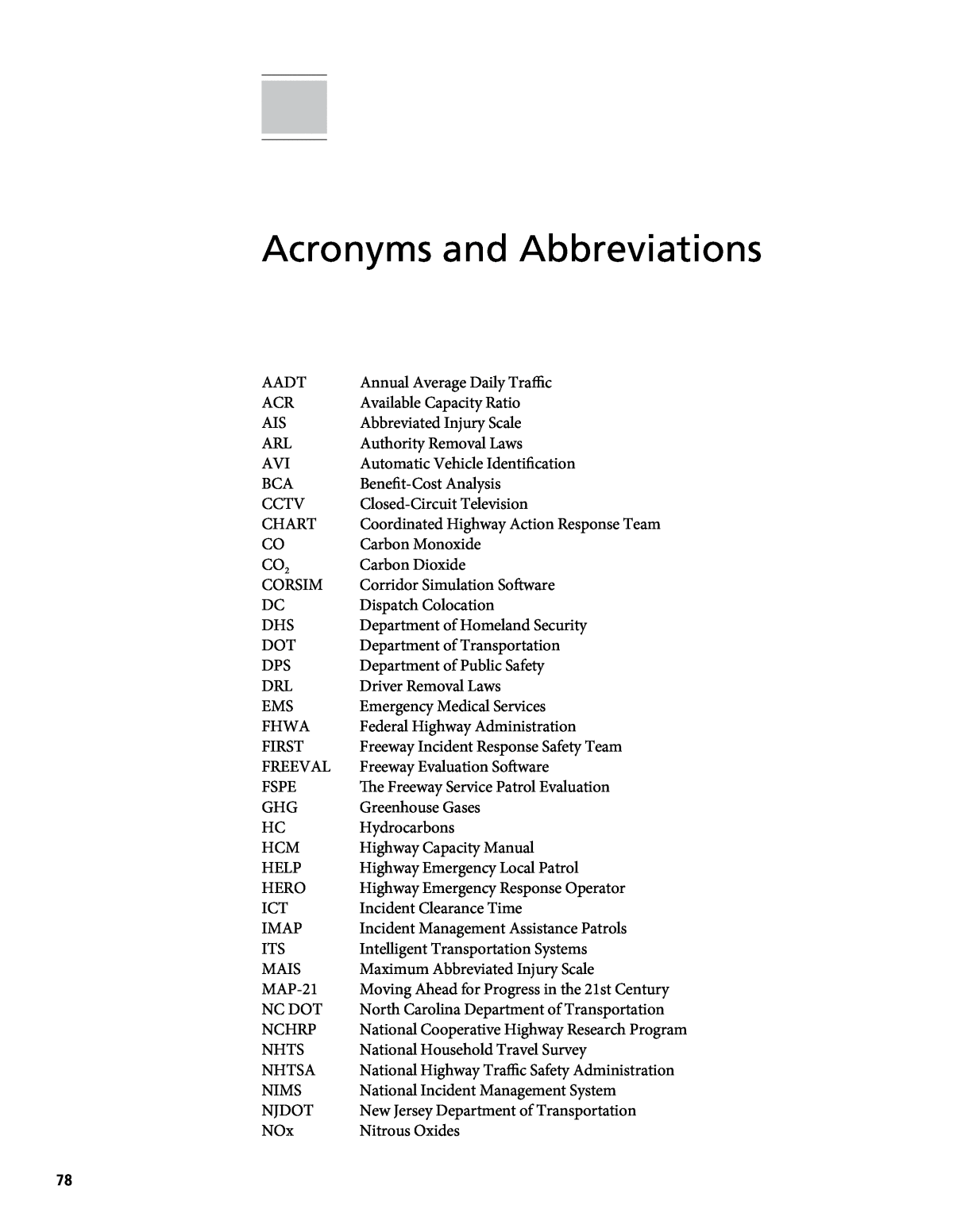




Below is the uncorrected machine-read text of this chapter, intended to provide our own search engines and external engines with highly rich, chapter-representative searchable text of each book. Because it is UNCORRECTED material, please consider the following text as a useful but insufficient proxy for the authoritative book pages.
78 Acronyms and Abbreviations AADT Annual Average Daily Traffic ACR Available Capacity Ratio AIS Abbreviated Injury Scale ARL Authority Removal Laws AVI Automatic Vehicle Identification BCA Benefit-Cost Analysis CCTV Closed-Circuit Television CHART Coordinated Highway Action Response Team CO Carbon Monoxide CO2 Carbon Dioxide CORSIM Corridor Simulation Software DC Dispatch Colocation DHS Department of Homeland Security DOT Department of Transportation DPS Department of Public Safety DRL Driver Removal Laws EMS Emergency Medical Services FHWA Federal Highway Administration FIRST Freeway Incident Response Safety Team FREEVAL Freeway Evaluation Software FSPE The Freeway Service Patrol Evaluation GHG Greenhouse Gases HC Hydrocarbons HCM Highway Capacity Manual HELP Highway Emergency Local Patrol HERO Highway Emergency Response Operator ICT Incident Clearance Time IMAP Incident Management Assistance Patrols ITS Intelligent Transportation Systems MAIS Maximum Abbreviated Injury Scale MAP-21 Moving Ahead for Progress in the 21st Century NC DOT North Carolina Department of Transportation NCHRP National Cooperative Highway Research Program NHTS National Household Travel Survey NHTSA National Highway Traffic Safety Administration NIMS National Incident Management System NJDOT New Jersey Department of Transportation NOx Nitrous Oxides
Acronyms and Abbreviations 79Â Â OMB Office of Management and Budget OST Office of Secure Transportation PDO Property Damage Only PTSA Pre-established Towing Service Agreements QBAM Quick Benefits Analysis Method RCT Roadway Clearance Time REACT Regional Emergency Action Coordination Team RIMS Rutgers Incident Management System SHRP2 Second Strategic Highway Research Program SQCG Shared Quick Clearance Goals SSP Safety Service Patrol SSP-BC Safety Service Patrol Benefit-Cost STIP State Transportation Improvement Plan TIGER Transportation Investment Generating Economic Recovery TIM Traffic Incident Management TIM-BC Traffic Incident Management Benefit-Cost TIM-TF TIM Task Forces TMDD Traffic Management Data Dictionary TOPS-BC Tool for Operations Benefit/Cost TR SHRP2 Training TRB Transportation Research Board TTI Texas A&M Transportation Institute U.S. DOT United States Department of Transportation VCTIR Virginia Transportation Research Council VSL Value of a Statistical Life WSDOT Washington State Department of Transportation
Abbreviations and acronyms used without definitions in TRB publications: A4A Airlines for America AAAE American Association of Airport Executives AASHO American Association of State Highway Officials AASHTO American Association of State Highway and Transportation Officials ACIâNA Airports Council InternationalâNorth America ACRP Airport Cooperative Research Program ADA Americans with Disabilities Act APTA American Public Transportation Association ASCE American Society of Civil Engineers ASME American Society of Mechanical Engineers ASTM American Society for Testing and Materials ATA American Trucking Associations CTAA Community Transportation Association of America CTBSSP Commercial Truck and Bus Safety Synthesis Program DHS Department of Homeland Security DOE Department of Energy EPA Environmental Protection Agency FAA Federal Aviation Administration FAST Fixing Americaâs Surface Transportation Act (2015) FHWA Federal Highway Administration FMCSA Federal Motor Carrier Safety Administration FRA Federal Railroad Administration FTA Federal Transit Administration GHSA Governors Highway Safety Association HMCRP Hazardous Materials Cooperative Research Program IEEE Institute of Electrical and Electronics Engineers ISTEA Intermodal Surface Transportation Efficiency Act of 1991 ITE Institute of Transportation Engineers MAP-21 Moving Ahead for Progress in the 21st Century Act (2012) NASA National Aeronautics and Space Administration NASAO National Association of State Aviation Officials NCFRP National Cooperative Freight Research Program NCHRP National Cooperative Highway Research Program NHTSA National Highway Traffic Safety Administration NTSB National Transportation Safety Board PHMSA Pipeline and Hazardous Materials Safety Administration RITA Research and Innovative Technology Administration SAE Society of Automotive Engineers SAFETEA-LU Safe, Accountable, Flexible, Efficient Transportation Equity Act: A Legacy for Users (2005) TCRP Transit Cooperative Research Program TDC Transit Development Corporation TEA-21 Transportation Equity Act for the 21st Century (1998) TRB Transportation Research Board TSA Transportation Security Administration U.S. DOT United States Department of Transportation
Transportation Research Board 500 Fifth Street, NW Washington, DC 20001 ADDRESS SERVICE REQUESTED ISBN 978-0-309-09416-0 9 7 8 0 3 0 9 0 9 4 1 6 0 9 0 0 0 0
